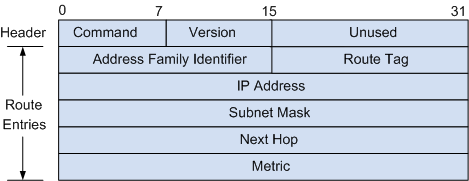RIP-2 Enhanced Features
Comparison Between RIP-1 and RIP-2
RIP-1 is a classful routing protocol, whereas RIP-2 is a classless routing protocol. In RIP-1, protocol packets can be advertised only in broadcast mode. Because RIP-1 packets do not carry any mask information, they identify only the routes of natural network segments (such as Class A, Class B, and so on). Therefore, RIP-1 does not support route summarization or discontiguous subnets.
Figure 1 and Figure 2 show the RIP-1 and RIP-2 packet formats.
RIP-2 has the following advantages over RIP-1:
Supports route tag and can flexibly control routes based on the tag in routing policies.
Supports mask information and can therefore support route summarization and Classless Inter-Domain Routing (CIDR).
Supports a next-hop address and can select the optimal next-hop address on broadcast networks.
Supports the sending of update packets in multicast mode. Only RIP-2 devices can receive RIP-2 packets, saving resources.
Provides packet authentication to enhance security.
RIP-2 Route Summarization
When different subnet routes within the same natural network segment are transmitted to other network segments, these routes are summarized into one route of the same network segment. This process is called route summarization. RIP-2 route summarization improves scalability and efficiency and reduces the size of the routing table for large networks.
RIP-2 route summarization is classified into two types:
RIP process-based classful summarization
Summarized routes are advertised using natural masks. For example, route 10.1.1.0/24 (metric=2) and route 10.1.2.0/24 (metric=3) are summarized as one route 10.0.0.0/8 (metric=2) in the natural network segment. RIP-2 supports classful summarization to obtain the optimal metric.
Interface-based summarization
You can specify a summarized address. For example, configure route 10.1.0.0/16 (metric=2) on an interface as the summarized route of route 10.1.1.0/24 (metric=2) and route 10.1.2.0/24 (metric=3).

